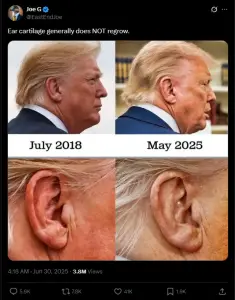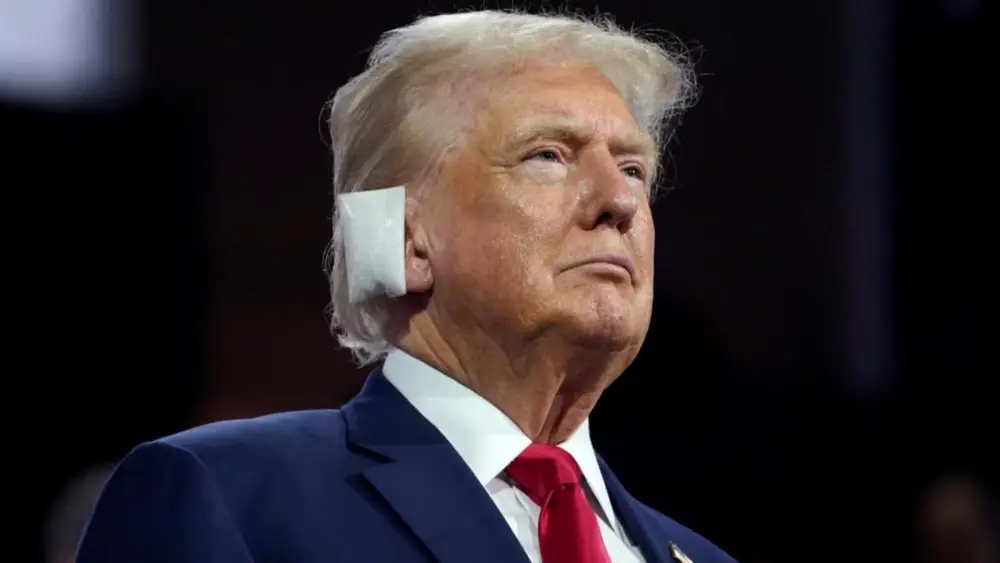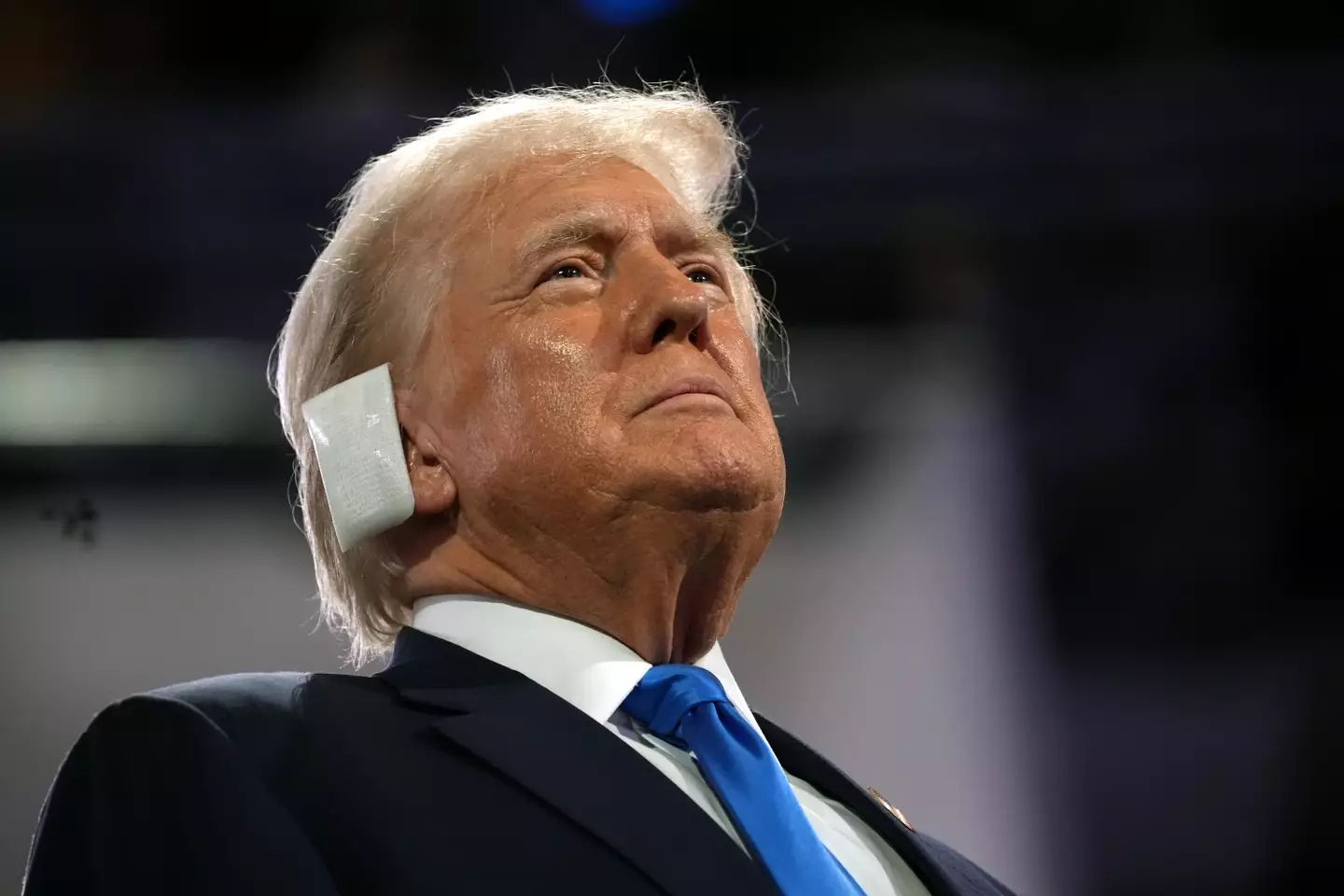In a political climate where truth and spectacle often blur, a fresh wave of conspiracy theories has engulfed social media—this time centered around former President Donald Trump and the now-infamous assassination attempt that occurred during a campaign rally in Pennsylvania. What should have been a moment of unity and collective concern over a near-tragedy has instead become a new breeding ground for online speculation.
While official sources and medical professionals confirmed the seriousness of the July 2024 incident, amateur internet sleuths are now digging into recent photos of Trump, pointing to what they claim is a major inconsistency: the condition of his ear. These users argue that photographic evidence—some grainy, some high-resolution—suggests the former president’s ear was never injured at all, reigniting the familiar yet unsettling trend of digital misinformation.
The theories range from claims of a “staged shooting” to full-blown accusations of body doubles and government collusion. And though these accusations have been thoroughly debunked by official statements, medical records, and live-streamed footage, they continue to thrive on platforms like X (formerly Twitter), Reddit, and TikTok. So what’s fueling this narrative, and why are so many people drawn to it?
The Shooting That Shook the Nation
The original incident took place during a campaign rally in Butler, Pennsylvania, on a sunny July afternoon in 2024. Trump was addressing a large crowd when a gunman, later identified as 20-year-old Thomas Matthew Crooks, climbed onto the roof of a nearby building and opened fire with an AR-15-style rifle.
The attack was swift and deadly. One supporter seated behind the former president was killed instantly. Two others sustained critical injuries. As bullets tore through the air, one appeared to graze Trump’s right ear, causing bleeding and momentary panic. Secret Service agents quickly surrounded him, shielding him from further harm. Crooks was fatally shot by federal agents shortly after.
Within moments, social media was flooded with clips and still images capturing the chaos. Photos of Trump’s bleeding ear, his dazed expression, and the rapid medical response all went viral. Over the next several days, news networks analyzed the event from every angle. For a brief moment, the nation was unified in shock.
The Rise of Conspiracy Claims
It didn’t take long, however, for internet forums and social media threads to pivot from sympathy to suspicion. Days after the incident, Trump was seen attending events wearing a red MAGA cap—his usual uniform—with no obvious sign of injury. Some users zoomed in on photos and began to question how someone whose ear was “grazed by a bullet” could look nearly healed so quickly.

A widely circulated post read:
“Ear cartilage generally does NOT regrow,” accompanied by side-by-side comparisons of Trump’s ear before and after the incident.
Another post went further, calling the event “likely the biggest scam ever,” insinuating that the former president or his allies may have staged the shooting for sympathy or political gain.
As of late June 2025, these theories had garnered tens of thousands of interactions on X and TikTok, sparking heated debate and further speculation.
What Supporters and Experts Are Saying
Not everyone is buying into the narrative. In fact, many users—both Trump supporters and critics—have stepped up to debunk the viral claims.
“It does [heal], and the bullet graze barely broke the skin. But you knew that,” one X user fired back at conspiracy theorists.
Another added:
“Y’all realize he’s a billionaire, right? You don’t think the world’s best plastic surgeons can repair an ear?”
Indeed, former White House physician Dr. Ronny Jackson, who examined Trump after the shooting, gave a detailed medical explanation at the time.
“There was initially significant bleeding, followed by marked swelling of the entire upper ear,” Jackson stated.
“The swelling has since resolved, and the wound is beginning to granulate and heal properly. Given the highly vascular nature of the ear, there is still intermittent bleeding requiring a dressing to be in place. Given the broad and blunt nature of the wound itself, no sutures were required.”
In layman’s terms, the bullet didn’t rip through the ear cartilage, but rather grazed the outer skin and tissue, which heals faster than people often assume.
Another user on X—who explicitly stated they were anti-Trump—criticized the conspiracy theorists for promoting what they described as “ridiculous” narratives.
“The FBI, which was under Biden’s control at the time, confirmed there was an injury. Medical professionals during the time confirmed that repairing his ear would not be hard and could be made to look normal,” they wrote.
Trump was seen with a bandage over his ear in the days after the attack (Andrew Harnik/Getty Images)
They further explained:
“The ear is full of blood vessels… there is going to be a lot of blood. The streaks of blood on his face are not from the bullet/shrapnel… whichever hit him I don’t care… something did… but those streaks happened when he went to the ground because he had to tip his head downwards which caused the blood to fall onto his face.”
They also pointed out a small but noticeable gap in the helix of Trump’s ear that wasn’t present in older photos, suggesting a subtle physical change consistent with trauma and recovery.
The Role of Technology in Fueling Misinformation
So why are so many people willing to believe that the assassination attempt was faked, despite evidence to the contrary?
Part of the answer lies in the democratization of media. In the age of high-resolution smartphones, real-time video, and deepfake technology, people are constantly comparing, analyzing, and remixing footage for clicks. The public’s access to raw data is unprecedented—but so is the public’s access to tools that can manipulate, distort, and reframe that data.
In a media landscape already plagued by skepticism and mistrust, even well-documented events are now being second-guessed by default. Combine that with Trump’s history of polarizing public opinion, and you have fertile ground for conspiracy theories to flourish.
The former president’s history of theatrical comebacks and headline-dominating events only adds to the perception that “nothing is off the table.” His critics see him as a master of distraction. His supporters see him as a survivor—both politically and, in this case, literally.
The Dangers of Conspiratorial Thinking
Medical professionals and security analysts have voiced concerns about the continued spread of misinformation regarding the shooting.
“It’s not just about Trump,” said Dr. Marla Henderson, a trauma specialist. “What worries me is that when you normalize doubting every event—especially one involving gun violence—you undermine public trust in emergency response systems, in medicine, and in truth itself.”
Henderson stressed that even minor injuries to the ear can appear more dramatic due to the high concentration of blood vessels, which explains why initial photos showed significant bleeding despite the wound being superficial.
Security experts also warned that claims of a staged attack could delegitimize the work of the Secret Service, which responded swiftly and decisively during the shooting.
“It disrespects the agents who put their lives on the line,” one retired Secret Service officer said anonymously. “One of them neutralized the shooter before he could do more damage. That’s not a hoax—that’s heroism.”
The Broader Implications for 2024 and Beyond
As the 2024 election cycle heated up, Trump’s rally in Pennsylvania became one of the most widely viewed political events of the year. The assassination attempt shifted the tone of the campaign almost overnight. It became a rallying cry for supporters and a moment of pause even among skeptics.
But now, with renewed online discourse around the event’s authenticity, the focus is shifting once again—from sympathy to suspicion.
For a significant segment of the population, the conspiracy theory provides a lens through which they process their distrust—not just of Trump, but of institutions, media, and each other. For others, it’s a dangerous and disrespectful rewriting of real trauma.
As of now, Trump continues to campaign vigorously, often referencing the shooting in his speeches as proof of what he describes as “spiritual warfare” against his movement.
“We’ve been through fire. We’ve been through blood. And we’re still standing,” he told supporters at a recent rally in Arizona.
Meanwhile, platforms like X and Reddit continue to be battlegrounds for conflicting narratives—some seeking truth, others seeking attention.
Final Thoughts: Between Reality and Rumor
The shooting in Butler, Pennsylvania, was an undeniable turning point in the 2024 election narrative. And yet, instead of being remembered solely as a moment of national concern and resilience, it now lives on in conspiracy threads and debunking efforts.
Whether driven by distrust, partisanship, or the adrenaline rush of amateur sleuthing, these theories underscore a sobering truth: In today’s digital age, no event is too sacred, too dangerous, or too documented to escape the court of public opinion.
Donald Trump, as ever, remains at the center of that storm.
https://x.com/EastEndJoe/status/1939508837389574328


